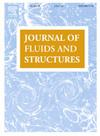Geometrically exact mechanics of pipes conveying fluid with an axially sliding downstream end
IF 3.5
2区 工程技术
Q1 ENGINEERING, MECHANICAL
引用次数: 0
Abstract
In this study, the post-buckling patterns and stability characteristics of hanging and standing soft pipes conveying fluid, with an axially sliding downstream end, are investigated using a new nonlinear geometrically exact model. The mathematical formulation in terms of the rotation angle and lateral displacement, is derived by incorporating the lateral constraint at the downstream end into the geometrically exact model of a cantilevered pipe conveying fluid in terms of the rotation angle. Additionally, a linearized mathematical model of the system around its post-buckling path is established to assess the stability characteristics of post-buckled configurations. To determine the post-buckling patterns and their stability behavior, the shooting scheme in conjunction with the Runge-Kutta finite difference method is utilized. The analysis focuses on both hanging and standing systems, where the downstream end is simply supported and the upstream end may be either clamped or simply supported, taking into account the simultaneous influences of flow velocity and gravity. Furthermore, in the case of the standing system with both ends simply supported, the potential for snap-through buckling is examined. Ultimately, the geometrically exact patterns are compared with those obtained by the original and approximate versions of the nonlinear third-order model.
具有轴向滑动下游端输送流体的管道的几何精确力学
本文采用一种新的非线性几何精确模型,研究了下游端轴向滑动的悬挂式和直立式软管道的后屈曲模式和稳定性特性。通过将下游端的横向约束纳入悬臂管输送流体的旋转角度几何精确模型,推导出了旋转角度和横向位移的数学表达式。此外,建立了系统后屈曲路径的线性化数学模型,以评估后屈曲构型的稳定性特性。为了确定后屈曲模式及其稳定性行为,采用了结合龙格-库塔有限差分法的射击方案。考虑到流速和重力的同时影响,下端采用简支,上端采用夹紧或简支的悬挂式和立式两种系统进行了分析。此外,在两端简单支撑的站立系统的情况下,检查了卡嗒通屈曲的可能性。最后,将几何上精确的图形与非线性三阶模型的原始和近似版本所得到的图形进行了比较。
本文章由计算机程序翻译,如有差异,请以英文原文为准。
求助全文
约1分钟内获得全文
求助全文
来源期刊

Journal of Fluids and Structures
工程技术-工程:机械
CiteScore
6.90
自引率
8.30%
发文量
173
审稿时长
65 days
期刊介绍:
The Journal of Fluids and Structures serves as a focal point and a forum for the exchange of ideas, for the many kinds of specialists and practitioners concerned with fluid–structure interactions and the dynamics of systems related thereto, in any field. One of its aims is to foster the cross–fertilization of ideas, methods and techniques in the various disciplines involved.
The journal publishes papers that present original and significant contributions on all aspects of the mechanical interactions between fluids and solids, regardless of scale.
 求助内容:
求助内容: 应助结果提醒方式:
应助结果提醒方式:


